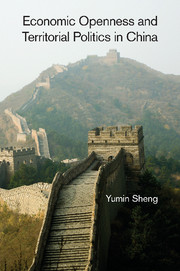Book contents
- Frontmatter
- Contents
- List of Tables
- List of Figures
- Acknowledgments
- List of Abbreviations
- 1 The Territorial Politics of Economic Openness in China
- 2 Globalization, Institutions, and Domestic Territorial Politics: A Theoretical Framework
- 3 Economic Openness and Its Regional Dimension
- 4 Central Political Control via the CCP
- 5 Global Market Integration and Central Political Control
- 6 Consequences for Fiscal Extraction and Economic Growth
- 7 Globalization, Single-Party Rule, and China's Transitions
- References
- Index
3 - Economic Openness and Its Regional Dimension
Published online by Cambridge University Press: 10 November 2010
- Frontmatter
- Contents
- List of Tables
- List of Figures
- Acknowledgments
- List of Abbreviations
- 1 The Territorial Politics of Economic Openness in China
- 2 Globalization, Institutions, and Domestic Territorial Politics: A Theoretical Framework
- 3 Economic Openness and Its Regional Dimension
- 4 Central Political Control via the CCP
- 5 Global Market Integration and Central Political Control
- 6 Consequences for Fiscal Extraction and Economic Growth
- 7 Globalization, Single-Party Rule, and China's Transitions
- References
- Index
Summary
INTRODUCTION
Under growing economic globalization, economic disparity within countries tends to widen as differentially endowed subnational regions fare differently in the world markets. The winner regions become more assertive in clamoring for greater fiscal and even political autonomy, and in resisting central demands for more revenue contributions. The loser regions start crying for more fiscal assistance from the central government. There are mounting strains in the center's ability to pursue fiscal transfers for mitigating the yawning economic gap among the regions. In time, fissiparous tendencies develop and territorial challenges to the national-level political authority start to emerge from below. So goes the storyline of the prevailing economic theories.
How does the story of post-1978 China fit these stylized facts? I start this chapter by reviewing some national-level economic trends and policies related to the country's recent but rapid embrace of the global markets. However, I focus on the regional dimension. Of primary interest are the following questions: What were the central government's foreign economic policies for the provinces? What were the patterns of cross-province variation in the actual degree of participation in economic globalization during this period? How did increasing exposure to the global markets affect the economic schism among the provinces? Did globalization unleash similar centrifugal forces from below? If yes, how did Beijing respond?
To a certain extent, the pursuit of economic efficiency gains under the rising “opportunity costs of closure” prompted the first opening in the late 1970s and has sustained it ever since.
- Type
- Chapter
- Information
- Economic Openness and Territorial Politics in China , pp. 49 - 99Publisher: Cambridge University PressPrint publication year: 2010



